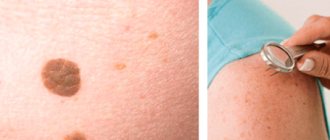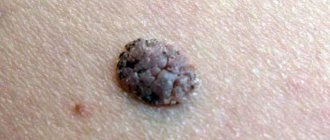How does the healing process work?
- 3-4 hours after removal of the mole, the wound is covered with a dark dense crust. And after a few hours, the area around it swells and turns red. This is an absolutely normal reaction of the body. The entire healing process lasts from 14 days to a month.
- First week. The scab that appears at the site of the birthmark is prohibited from being torn off. It has a protective function: to protect the wound from infection and allow new tissue to grow. The wound is protected from mechanical damage, friction with clothing, a bath sponge, and scratching. You should also not use cosmetic creams.
Frequently asked question: can a scar or scar appear at the site of a removed mole? Such a nuisance can happen if the protective scab is torn off from the wound surface. Therefore, doctors strongly recommend protecting the wound from outside interference.
- Second week. After about 7-10 days, the dry crust disappears on its own. Instead, a pale pink skin remains. It should not be exposed to sunlight. If the mole was on the face, then use sunscreen with SPF 50. Otherwise, unwanted pigmentation may occur.
- The next two weeks. Usually, by day 20, the site of the removed mole is overgrown with full healthy skin. A slight itching may occur at the wound site, but special skin care is no longer required after getting rid of the birthmark. A month after the operation, the scar from the birthmark will smooth out, and after 2 months only an inconspicuous microscar will remain.
Indications for use
Potassium permanganate is used as a disinfectant, and also as an antidote for alkaloid poisoning for:
- External treatment of wound surfaces
- Carrying out mouth rinsing procedures
- Rubbing the surface of ulcers and burns
- Douching and rinsing (in gynecology and urology)
- Gastric lavage for chemical poisoning caused by oral intake of morphine, phosphorus, aconitine and a number of alkaloids.
Potassium permanganate can also be used for cosmetic purposes to remove body hair, condylomas, moles, and tattoos.
Detailed instructions are available at the link:
How to care for a wound after mole removal
Sometimes the doctor prescribes treating the scab with disinfectants or ointment with an antimicrobial effect. The most popular care products after mole removal include:
- weak solution of potassium permanganate. It dries out the crust and has an antiseptic effect;
- alcohol solution of brilliant green, or brilliant green. Also a good antiseptic.
Otherwise, routine wound care after mole removal boils down to monitoring the damaged area. Signs of an incorrect healing process will be:
- purulent discharge;
- severe itching, wetness;
- prolonged bleeding;
- increased body temperature;
- noticeable swelling of the skin for several days.
If you notice these symptoms, contact your doctor.
Removal of moles, warts and keratomas in Butovo
And at the same time, any neoplasm on the skin usually causes more or less justified concern. This can be a purely physical inconvenience in cases of either constant compression of the tumor, for example, by folds of clothing, or, what is more dangerous, when the tumor is systematically damaged by cutting objects (when cutting or shaving).
Or it may also be in the form of aesthetic discomfort, as in cases of moles or other tumors located on open parts of the body or in “intimate” places. Naturally, a person has a desire to forever get rid of these neoplasms that interfere with normal life, and only a certified specialist - a dermatologist - can help him with this.
Let's talk about the most serious neoplasms - moles.
The reason for contacting a dermatologist can and should be simply a large number of moles. Not every one of them requires removal for medical reasons, and this kind of intervention will be justified only by the need for aesthetic correction. But some of them are subject to mandatory removal:
- located in areas where clothing or shoes fit tightly to the body;
- injured moles, especially when part of a mole is removed;
- and, especially, those that show signs of malignancy.
These signs include:
- compaction of the mole and increase in its size, including its height above the surface of the skin;
- change in the contour (appearance of uneven edges) and color of the mole (especially darkening and appearance of spots of a different color against the background of the main color);
- the appearance of gloss and bleeding cracks on the surface of the mole;
- disappearance of the skin pattern from the surface of the mole;
- sensation of pain, itching, tingling or numbness of the mole.
What restrictions exist after the procedure?
- In the first three to five days after the procedure, alcohol is excluded from the diet. Alcoholic drinks dilate blood vessels, increasing the likelihood of bleeding.
- For two weeks after laser removal of a birthmark, you should avoid contact with water. It is recommended not to visit the bathhouse, sauna, or swimming pool.
- You will have to protect your skin from sunlight and solarium lamps for a whole month. This will save you from possible hyperpigmentation.
If you follow simple wound care rules after mole removal, recovery will be quick and painless.
The use of potassium permanganate in cosmetology
A solution of potassium permanganate of varying concentrations can be used to remove hair in a particular area of the body.
The rules for preparing the solution are as follows: dilute the powder in a glass of warm water (approximately on the tip of a knife), stir well, and then let it brew for a while so that all the crystals are completely dissolved in the liquid. Then the solution must be filtered through several layers of gauze, avoiding any sediment from getting into the container with the strained liquid.
Steam bath with potassium permanganate
The effectiveness of this procedure is low, since it implies a gentle effect on the hair and skin. Using this method, you can remove hair with potassium permanganate in the bikini area; the procedure will not harm the mucous membranes. Before a steam bath with potassium permanganate is carried out, you need to dilute the powder in hot water to a light pink tint. You can take baths every day for 25 minutes. until the desired effect is achieved. It is worth taking into account that potassium permanganate can stain the skin.
Taking local baths
The prepared solution should be poured into a deep container (for example, a basin) and put your hands or feet there. With an increased concentration of potassium permanganate in the liquid (transparent solution of saturated crimson color - 2%), the time of exposure of the solution to the skin of the legs and arms should not exceed 20 minutes.
A bath with potassium permanganate can also be prepared. This involves immersing the entire body. It is worth noting that a bath with potassium permanganate can only be taken with a cap on the head. The duration of the procedure is 30 minutes. Thus, it will be possible to get rid of hair not only on the surface of the legs and arms, but also on the entire body.
How is hair burning done?
To carry out this procedure, it is necessary to use a highly concentrated, 5% solution of manganese (after diluting the potassium permanganate crystals, the liquid becomes dark purple in color). For one use you will need approximately 200 ml, that is, for this amount of liquid you will need 10 g of potassium permanganate. You can apply the prepared concentrate locally using a cotton pad or with a cotton swab directly on the scalp of your legs or arms. Thanks to this procedure, you can quickly get rid of unwanted hair, since manganese “burns out” the hair follicles. After this, there is no need to rinse the area of the legs or arms treated with potassium permanganate with water.
How to remove a tattoo with potassium permanganate
There are many ways to remove a tattoo; this method can be used at home. Apply potassium permanganate powder to the tattoo, then moisten the area using a spray bottle. Next, you should wrap the treated tattoo with a piece of plastic film. After 2-4 hours, it will be possible to evaluate the result of the tattoo removal procedure. Potassium permanganate corrodes the tattoo itself and the skin, which is why wounds appear. After washing the ulcers with water, it is worth lubricating its surface with an antiseptic and regenerating ointment. When the wounds are completely healed, the tattoo will not be visible.
Removing moles on the body
Moles, like tattoos, can be removed on the body with a “strong” solution of potassium permanganate (5%). After diluting the potassium permanganate crystals in water, the liquid must be poured into a dark glass bottle and left to infuse in a dark place for 30 days. Next, using a cotton swab, the surface of the mole is treated, the procedures are carried out until the neoplasm is completely removed from the skin.
It is worth noting that potassium permanganate can dye the skin a dark shade. A few days after completion of the procedures, the skin will gradually clear, as when removing a tattoo.
Use during pregnancy and breastfeeding
It is contraindicated to use potassium permanganate, as well as a solution with iodine, during pregnancy and lactation for the purpose of taking a bath to get rid of unwanted hair on the surface of the legs and arms, burning out moles and tattoos. During pregnancy, potassium permanganate has a toxic effect not only on the mother’s body, but also on the child. You should not experiment during pregnancy; you can find many safe ways to remove hair at home.
Moles and melanomas
A nevus or mole is a benign skin growth consisting of melanocytes. There are two large groups of nevi:
- congenital, arising due to hereditary predisposition
- acquired, appearing due to exposure to ultraviolet radiation
A nevus is a benign tumor. Hormonal changes, traumatic effects and other factors can trigger the transformation of a nevus into melanoma, that is, skin cancer. With early diagnosis and radio removal of moles that are potentially dangerous to human life and health, the patient can avoid further progression of cancer. However, bringing melanoma to late stages makes the prognosis of this disease extremely disappointing.
Important! A neoplasm appears when pathological cells grow excessively. Modified cells continue to actively reproduce, despite the elimination of the factors that caused the failure of their development mechanism, so they must be removed.
There is a simple way to independently check nevi for the need for surgical intervention. Signs of possible melanoma:
- asymmetrical shape
- blurred boundaries
- multicolor
- dimensions exceeding 6 cm in diameter
- constant growth and visual change
- anxiety, itching, pain
In addition, if there are many nevi of the same type and one or several with differences from all the others, melanoma is suspected. Such “excellent” moles must be removed and histologically examined. To do this, it is necessary to use radio wave surgery to remove moles, since it is this method that allows you to save material for biopsy.
There are two reasons why nevi are removed:
- medical – the decision to remove is made by the doctor
- aesthetic – the patient independently decides that it is necessary
Radiosurgical removal of moles has the following contraindications:
- process of cancerous degeneration of nevus
- acute stage of chronic disease
- herpes
- hormonal imbalances that occur during menstruation, pregnancy, lactation
- history of glaucoma, epilepsy, diabetes mellitus
- infectious infection
- presence of an installed heart rate sensor
- chronic skin disease
Important! Before the radiosurgery procedure, you should be examined by an oncologist and a dermatologist to determine the nature of the tumor and identify possible contraindications to the use of this method. It is also important to exclude hormonal disorders, early pregnancy and the onset of menstruation.
If skin cancer is suspected, a subsequent biopsy of the removed nevus will answer the following questions:
- was the nevus melanoma?
- and whether it was completely removed or not
With proper and final removal, this formation will never bother you again.
Laser mole removal takes a long time to heal.
The healing time depends on the size of the mole, location, and individual characteristics of the regenerative processes.
If they are small in size, up to 0.5 cm, moles heal in 10-14 days; if they are larger than 1 cm, regeneration takes up to 3-4 weeks.
In places with good blood supply and in open areas of the body, healing is faster, up to 14 days. In places that are subject to friction (belt, bra line, groin area), get wet (perineum, armpits), have thick skin and poor blood flow (sole, palm), healing takes up to 4 weeks.
Radio knife: principle of influence
The instrument used to remove moles using the radio wave method is multifunctional and absolutely safe. Radio knife “Surgitron” during surgery:
- completely sterilizes the affected area
- performs tissue excision with high precision
- painlessly “seals” small vessels, preventing bleeding
It is these factors that ensure the safety of the procedure and the absence of side effects. Using a radio knife, by adjusting the power and frequency of the radio wave, you can remove nevi, papillomas, warts and other tumors, excluding the impact on healthy epidermal cells.
Control over the depth and area of non-contact surgical intervention allows you to achieve an excellent cosmetic effect. Removing moles with a radio knife guarantees the absence of scars at the excision sites. Moreover, unlike laser burning, the pathological material is suitable for further biopsy and clarification of its nature.
Important! Radiosurgical procedures are performed without mechanical pressure on the pathological formation and without crushing the cellular structure of the nevus. Carbonization of tissues, which is possible when using electrosurgical, pulsed, mid-frequency and low-frequency equipment, is excluded.
During the operation, a high-frequency radio signal is sent to the electrode of the radioknife. The thinnest wire, made of a special tungsten alloy, which does not heat up from such exposure, receives radio wave energy and directs this flow to the pathological tissue. The specificity of the interaction between radio waves and tissue cells guarantees thorough and precise excision of skin defects. The radioknife acts exclusively on the superficial layers of the epidermis (30–70 microns).
Analogs
Alcohol solution with iodine
Samaramedprom, Russia Price from 11 to 50 rub.
An alcohol solution with iodine is a universal antiseptic that is used to treat infected skin and mucous membranes. A solution with iodine is also used by cosmetologists to get rid of hair on the surface of the legs and arms, as well as moles.
Pros:
- Low price for solution with iodine
- Simplicity and ease of use of iodine baths
- Available without a prescription.
Minuses:
- Iodine solution is contraindicated for use during pregnancy
- High risk of developing allergies
- Iodine can be used to dye the skin.










